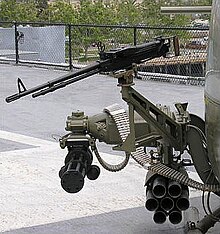
The Bell UH-1 Iroquois is a utility military helicopter designed and produced by the American aerospace company Bell Helicopter. It is the first member of the prolific Huey family, as well as the first turbine-powered helicopter in service with the United States military.

The Sikorsky SH-60/MH-60 Seahawk is a twin turboshaft engine, multi-mission United States Navy helicopter based on the United States Army UH-60 Black Hawk and a member of the Sikorsky S-70 family. The most significant modifications are the folding main rotor and a hinged tail to reduce its footprint aboard ships.

A carrier air wing is an operational naval aviation organization composed of several aircraft squadrons and detachments of various types of fixed-wing and rotary-wing aircraft. Organized, equipped and trained to conduct modern US Navy carrier air operations while embarked aboard aircraft carriers, the various squadrons in an air wing have different but complementary missions, and provide most of the striking power and electronic warfare capabilities of a carrier battle group (CVBG). While the CVBG term is still used by other nations, the CVBG in US parlance is now known as a carrier strike group (CSG).
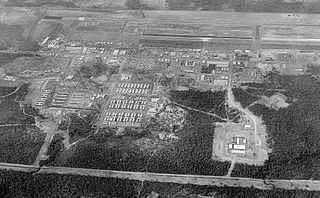
The Nakhon Phanom Royal Thai Navy Base (NKP), formerly Nakhon Phanom Royal Thai Air Force Base, is a Royal Thai Navy facility used for riverine patrols along the Mekong River. It is approximately 587 km northeast of Bangkok, 14.5 km west of Nakhon Phanom city in Nakhon Phanom Province in the northeastern region of Thailand, and 411 km from Hanoi in Vietnam. The Mekong River is NKP's border with Laos. The airfield at NKP is jointly used as a civilian airport.

The 129th Rescue Wing is a unit of the California Air National Guard, stationed at Moffett Federal Airfield in Sunnyvale, California. The wing is equipped with the HC-130J Combat King II and the HH-60G Pave Hawk helicopter. If activated to federal service, the wing is assigned to the United States Air Force's Air Combat Command (ACC).

The United States Air Force Combat Rescue School, was an organization of the United States Air Force.

Helicopter Sea Combat Squadron Eight (HSC-8) "Eightballers" is a United States Navy helicopter squadron based at Naval Air Station North Island, San Diego, California. HSC-8 is attached to Carrier Air Wing 11 (CVW-11) and deploys aboard USS Theodore Roosevelt. HSC-8 was redesignated from HS-8 on 28 September 2007.

The 550th Special Operations Squadron was a special operations flying training squadron of the United States Air Force.

Helicopter Sea Combat Squadron 84 (HSC-84) "Red Wolves" was a helicopter squadron of the United States Navy Reserve. Along with the "Firehawks" of HSC-85, the “Red Wolves” were one of only two squadrons in the U.S. Navy dedicated to supporting Navy SEAL and SWCC Teams, and Combat Search & Rescue. Prior to their deactivation in March 2016 they operated 14 HH-60H Rescue Hawks organized into four independent, two aircraft detachments that could deploy anywhere in the world within 72 hours of notice.

The 129th Rescue Squadron is a unit of the California Air National Guard 129th Rescue Wing located at Moffett Federal Airfield, Mountain View, California. The 129th is equipped with the HH-60G Pave Hawk helicopter. If activated to federal service, the 129 RQS is gained within the United States Air Force by the Air Combat Command (ACC).

Helicopter Sea Combat Squadron 25 (HSC-25) "Island Knights" is a United States Navy helicopter squadron based at Andersen Air Force Base, Guam. The "Island Knights" of HSC-25 fly the MH-60S "Knighthawk" helicopter, manufactured by Sikorsky Aircraft Corporation in Stratford, Connecticut.
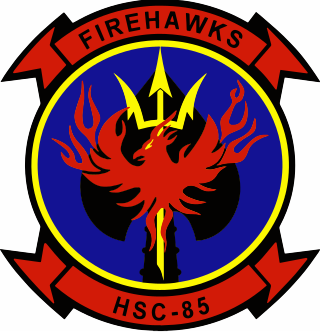
Helicopter Sea Combat Squadron EIGHT FIVE (HSC-85) is a United States Navy Reserve forces helicopter squadron (RESFORON) based out of Naval Air Station North Island in San Diego, California. The "FIREHAWKS" of HSC-85 are Reserve and Active Component Sailors who operate and maintain Sikorsky MH-60S Seahawk helicopters.

Helicopter Sea Combat Squadron 12 (HSC-12)Golden Falcons is a United States Navy helicopter squadron formerly designated HS-2, based at Naval Air Facility Atsugi, in Japan. They are attached to Carrier Air Wing Five with the aircraft carrier USS Ronald Reagan.

The 563rd Rescue Group is a United States Air Force unit stationed at Davis-Monthan Air Force Base, Arizona. The group also controls the rescue squadrons at Nellis Air Force Base, Nevada. It is assigned to the 355th Wing. The group directs flying operations dedicated to personnel recovery and is part of Air Combat Command. The group was activated under its current designation at Davis-Monthan in 2003 to command rescue units in the western United States.

Helicopter Anti-Submarine Squadron 10 (HS-10) was a United States Navy helicopter anti-submarine squadron based at Naval Air Station North Island, San Diego, California. Helicopter Anti-Submarine Squadron 10 (HS-10), a shore-based unit of Helicopter Anti-Submarine Wing, U.S. Pacific Fleet, was established on 30 June 1960 at NALF Imperial Beach, California. HS-10 was relocated to Naval Air Station North Island, San Diego, California on 23 December 1976.
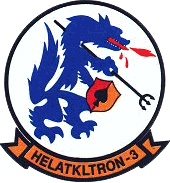
HA(L)-3,, nicknamed the "Seawolves", was an all-volunteer squadron in the US Navy formed in support of Naval Special Warfare operations and Mobile Riverine Forces during the Vietnam War.
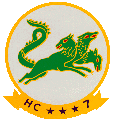
Helicopter Combat Support Squadron Seven (HC-7) was a helicopter squadron of the United States Navy established on 1 September 1967 and disestablished on 30 June 1975.

Helicopter Maritime Strike Squadron 49 (HSM-49) is a United States Navy Maritime Strike helicopter squadron based Naval Air Station North Island, California.

Helicopter Sea Combat Squadron 2 , also known as the "Fleet Angels", is a helicopter squadron of the United States Navy based at Naval Station Norfolk operating the Sikorsky MH-60S Seahawk. The Fleet Angels are a Fleet Replacement Squadron providing trained MH-60S crew to units on the East Coast.

